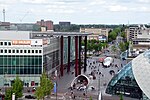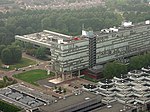Catharina Ziekenhuis
Buildings and structures in EindhovenTeaching hospitals in the Netherlands

Catharina Ziekenhuis (English: Catharina Hospital) is a teaching hospital in Eindhoven, Netherlands. The hospital was founded in 1843, and has been at its current location since 1973. It is one of two hospitals in the city of Eindhoven, the other is Máxima Medisch Centrum, and it is the biggest hospital in the larger Eindhoven region.
Excerpt from the Wikipedia article Catharina Ziekenhuis (License: CC BY-SA 3.0, Authors, Images).Catharina Ziekenhuis
Michelangelolaan, Eindhoven Woensel-Zuid
Geographical coordinates (GPS) Address Website External links Nearby Places Show on map
Geographical coordinates (GPS)
| Latitude | Longitude |
|---|---|
| N 51.4658 ° | E 5.4717 ° |
Address
Catharina Ziekenhuis
Michelangelolaan 2
5623 EJ Eindhoven, Woensel-Zuid
North Brabant, Netherlands
Open on Google Maps






